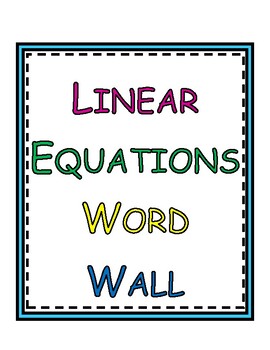Linear Equations - WORD WALL and ANCHOR Posters
- PDF
Also included in
- Students become proficient at manipulating, identifying features, graphing, and modeling with two-variable linear equations, inequalities, scatter plots and systems. Students are introduced to inverse functions and formalize their understanding on linear systems of equations and inequalities to modePrice $192.82Original Price $214.25Save $21.43
Description
This word wall includes details about each term used in reference to Linear Equations. The terms/concepts included are as follows:
- Ordered Pairs
- Cartesian Plane
- x-movement
- x-value
- y-movement
- y-value
- Quadrant Plane
- Slope with 4 different formula views
- Slope Forming a Triangle to show movement
- Slope in a Graph
- Slope in a Table
- Slope in an Equation
- Forms of Linear Equations
- Slope-Intercept Form
- Standard Form
- Point-Slope Form
- Undefined Slope
- Zero Slope
- Parallel Slopes
- Perpendicular Slopes
- Positive Slopes
- Negative Slopes
- X-Intercept in a graph, table and equation
- Y-Intercept in a graph, table and equation
- Systems of Equations
- Solving Systems of Equations by Graphing
- Solving Systems of Equations by Substitution
- Solving Systems of Equations by Elimination
- Meaning of Substitution
- Meaning of Elimination
- Domain
- Range
Terms of Use:
Products by MATHerpieces, LLC may be used by the purchaser for their classroom use only. All rights reserved. No part of this publication may be reproduced, distributed, or transmitted without written permission of the author. Classroom websites, network drives, or personal sites are not permitted. If you would like to share documents with your students, please be sure they are password protected. If you wish to share this product with your team or colleagues, you may purchase additional licensing at a discounted rate.
If other teachers at your campus are interested in purchasing, additional licenses must be purchased. Teachers Pay Teachers accepts purchase orders, information can be found here. Feel free to contact me for specific pricing details and/or questions.
Questions:
If you have any questions, please feel free to email me or use the Ask a Question feature in TpT. I want to provide quality products to help teachers and students alike, so contact me before leaving feedback if you have a need. ©MATHerpieces LLC, 2012-present






